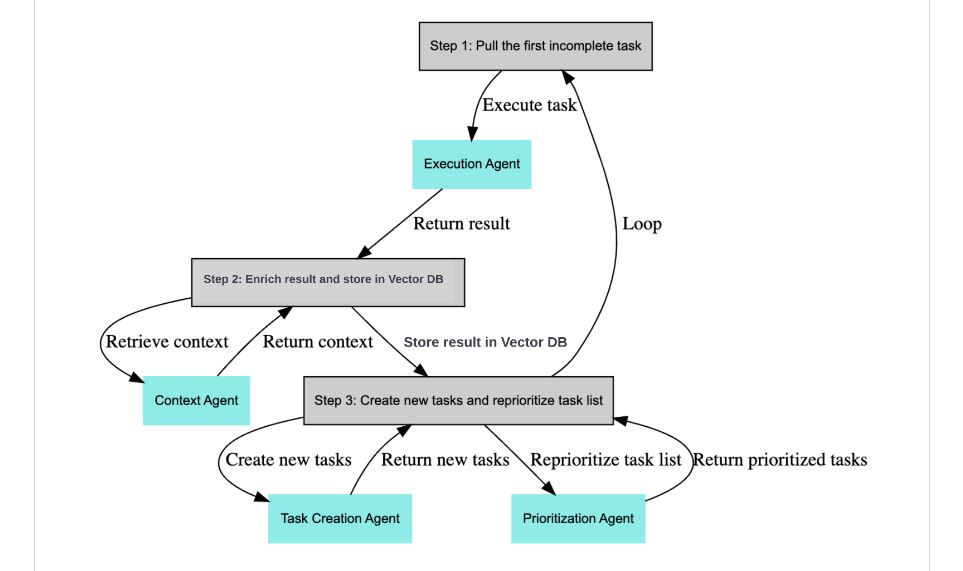BabyAGI: An Overview of the Task-Driven Autonomous Agent
Introduction to BabyAGI
BabyAGI, developed by Yohei Nakajima, is a pioneering autonomous AI-powered task management system utilizing advanced technologies to automate diverse tasks, thereby streamlining processes and boosting efficiency across multiple applications. BabyAGI, as AI-powered agent, has offered an example develped in Python language. The system uses OpenAI and vector databases such as Chroma or Weaviate to create, prioritize, and execute tasks. The main idea behind this system is that it creates tasks based on the result of previous tasks and a predefined objective. The script then uses OpenAI's natural language processing (NLP) capabilities to create new tasks based on the objective, and Chroma/Weaviate to store and retrieve task results for context. This is a pared-down version of the original Task-Driven Autonomous Agent
BabyAGI, conceptualized by Yohei Nakajima, is a pioneering autonomous AI agent, leveraging sophisticated technologies to automate a vast array of tasks, thus enhancing efficiency and streamlining processes in various domains. Instantiated and Developed in Python, this AI-driven task management system notably employs OpenAI's NLP prowess along with vector databases like Chroma and Weaviate for task generation, prioritization, and execution. Central to its design is the dynamic creation of tasks, informed by the outcomes of preceding tasks and a specified objective. Utilizing OpenAI for task generation and Chroma/Weaviate for context-driven storage and retrieval of task results, BabyAGI represents a streamlined adaptation of the original Task-Driven Autonomous Agent concept.
Why BabyAGI: Genesis of BabyAGI
BabyAGI originated from Yohei Nakajima's fascination with the concept of an "AI founder" capable of autonomously running a company. The inspiration stemmed from the #HustleGPT movement, where ChatGPT was utilized as a cofounder in business ventures. Nakajima's idea materialized into a base architecture that was iteratively refined through prompts to ChatGPT, leading to a working prototype.
Technical Framework
The system is built on the GPT-4 architecture and integrates technologies like Pinecone and the LangChain framework. It uses OpenAI's natural language processing (NLP) capabilities for task generation, management, and execution, based on user-defined objectives.
How BabyAGI works
Task Management Mechanism: BabyAGI operates by continuously prioritizing tasks necessary to achieve a set objective. This process involves four key steps:
- Pulling the first task from the list.
- Executing the task using OpenAI API.
- Storing the result in Chroma/Weaviate.
- Creating and prioritizing new tasks based on the objective and outcome of the previous task

BabyGPT Work Flow, Source: Github
The system incorporates a global JSON variable produced by GPT-4, which enhances its information processing efficiency.
Example Application: An exemplary use case involves setting an objective like "Add 1000 Twitter followers in 30 days." BabyAGI then generates a task list and executes the tasks, continuously updating and prioritizing them based on outcomes. This process demonstrates BabyAGI's capability to handle complex, iterative tasks with a degree of autonomy.
Evolution and Variants
BabyBeeAGI: An expanded version, BabyBeeAGI, introduces modifications like complex task management prompts, dependent tasks, adaptability to shorter tasks, and additional tools like web search and scrape capabilities. These enhancements broaden BabyAGI's applicability and set the stage for more sophisticated AI applications.
Future Developments: Plans for BabyAGI's evolution include integrated security/safety agents, parallel task execution, and further refinement of its autonomous capabilities.
Implications and Considerations
Potential Applications: BabyAGI offers vast possibilities in task management, from simple operations to complex, multi-step processes. Its adaptability makes it suitable for a range of applications, including project management, data entry, and more.
Limitations and Challenges: Despite its advancements, BabyAGI faces challenges like slower processing speeds due to complex integrations and the potential for occasional errors in its current iteration. These limitations underscore the need for continuous development and refinement.
Alternatives to BabyAGI
Zapier: A widely-used online automation tool that connects your favorite apps, such as Gmail, Slack, and over 2,000 more. It allows you to automate repetitive tasks without coding or relying on developers to build the integration.
IFTTT (If This Then That): This service enables you to create chains of simple conditional statements, called applets. These applets can automate tasks between different web services and IoT devices.
Integromat: An advanced online automation platform that enables you to automate tasks between various web services. It offers a visual editor to set up complex automation with multiple services.
Automation Anywhere: Automation Anywhere, provides a suite of tools to automate complex business processes. It is especially useful for larger enterprises with complex automation needs.
n8n.io: An open-source workflow automation tool. It uses a visual interface for creating workflows and can integrate with various online services and tools.
UiPath: Focused on Robotic Process Automation, UiPath allows organizations to automate repetitive office tasks. It's powerful for businesses looking to streamline their workflows with automation.
Workato: An integration and automation platform that connects your apps and automates your business workflows. It's designed for both business and IT teams to effectively automate processes.
AgentGPT: A cutting-edge autonomous AI platform that enables users to design and deploy personalized autonomous AI agents directly on the internet. This detailed study examines the characteristics, capabilities, practical applications, and future potential of Agent GPT.
Tray.io: Offers a sophisticated workflow automation platform targeted at enterprise needs. It connects various cloud-based services and automates complex processes.
Conclusion
BabyAGI represents a significant stride in the domain of AI-powered task management. By automating and streamlining tasks, it not only enhances operational efficiency but also provides insights into the capabilities and future potential of autonomous AI agents. As the system evolves, it is poised to play a pivotal role in various industries, reshaping how tasks are managed and executed.
